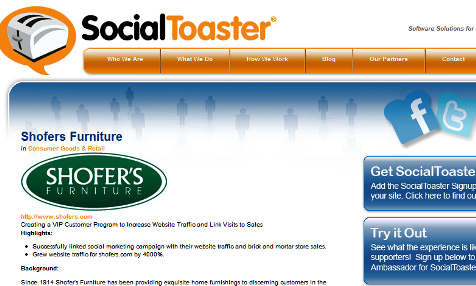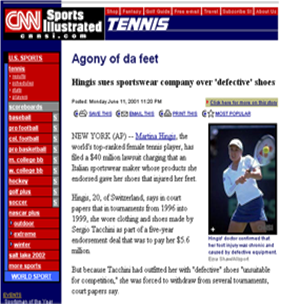 Are you prepared to put your customers in charge of your brand… literally?
Are you prepared to put your customers in charge of your brand… literally?
What would happen if you gave your customers the keys to your corporate social media channels? This article reviews the rewards and the risks marketers face as they decide how much brand control they're willing to give up.
Marketers are just coming to terms with how to deal with customers having free rein to either praise or bash their companies, but I think there may be a new trend on the horizon—the customer brand ambassador.
You have customers who love your brand and rave about it. But their reach only extends so far. Why not give them a platform to amplify their reach and spread the word? Think about it… It really could be a beautiful partnership.
We've seen examples of this with empowering customers to lead innovation in the company with product recommendations from Starbucks, GE and Intuit and their great examples of utilizing customer feedback in a controlled environment.

But this post is about something different. It's about a new approach, a new idea and a new way to look at involving your customers in social media. It's about how to put your customers in the driver's seat and actually allow them to run your corporate social media channels. Crazy? Maybe not.
Rewards of Giving Your Customers Access to Corporate Social Media Channels
#1: The power of a testimonial will outperform anything a marketer can develop.
The power of a customer's story has been proven to increase web traffic and conversions. But in this case, you would have customers who are building genuine relationships and showing that they're so passionate about your brand that it actually is part of their identity.
You could have customers who run an entire blog on your site, or one or more customers could be in charge of finding relevant articles they think your following would be interested in and sending out the tweets and status updates. Or from another angle, they could be charged with engaging with influential bloggers in your space and commenting on their blog posts on the company's behalf. There are so many possibilities for these loyal fans to become immersed in your brand and share their genuine unfiltered perspective.

If you're open to the possibilities, it isn't difficult to find activities that the company is comfortable with and customers are excited to be a part of. Shofer's Furniture implemented a brand ambassador program and had phenomenal results that increased their site traffic 4000%. And this doesn't mean that the company doesn't have access or also utilize these channels; it's a partnership of voices to leverage influence and networks from customers too.

#2: Customers can open doors faster than you can.
Let's face it, when bloggers are getting pitched by a brand, they immediately put up their sales radar. They want to protect their audience from your spammy marketing messages.
But when one of your customers approaches a blogger about the difference you made in their life, it's different. It doesn't feel like a pitch, it feels like a case study that must be shared.
If you set this up well, you'll allow the customer to leverage benefits he or she can offer to a blogger—a pseudo-toolbox of resources such as cross-posting on each other's blogs, joint media interviews and/or joint sponsorships. You'll have to do some training with your customers on how and when it's appropriate to use their toolbox, but it can be done.
A customer who knows when it's appropriate to say, “Hey, I also have some contacts over at the company and if you're interested in posting in their community I can make an introduction.” An approach like that doesn't sound salesy or pushy but natural, and builds on the power of social media to connect like-minded individuals.

Discover Proven Marketing Strategies and Tips
Want to go even deeper with your marketing? Check out the Social Media Marketing Podcast! Publishing weekly since 2012, the Social Media Marketing Podcast helps you navigate the constantly changing marketing jungle, with expert interviews from marketing pros.
But don’t let the name fool you. This show is about a lot more than just social media marketing. With over 600 episodes and millions of downloads each year, this show has been a trusted source for marketers for well over a decade.
#3: It's genuine, it's real, and it isn't marketing.
It's such a crowded marketplace for advertisers that it has become really tough to break through the clutter. And we're seeing this extend into the social space. By having a group of customers who are your brand ambassadors, you can easily break through with an authentic voice because it will sound different—ultimately it's humanization of your brand at its best.
Get World-Class Marketing Training — All Year Long!
Are you facing doubt, uncertainty, or overwhelm? The Social Media Marketing Society can help.
Each month, you’ll receive training from trusted marketing experts, covering everything from AI to organic social marketing. When you join, you’ll also get immediate access to:
- A library of 100+ marketing trainings
- A community of like-minded marketers
- Monthly online community meetups
- Relevant news and trends updates
As much as you try to develop pretty marketing messages that deliver, this will sound different than anything you put together. The reality is that even if the customer said EXACTLY what you would've said, it will have a tone of genuine passion behind it that marketers struggle to convey without sounding pushy.
The key is to get beyond the solicited customer testimonial and actually let them generate their own content in their own words. Facebook does a fantastic job with their Facebook Stories section. If it's appropriate for you to be involved in their content creation process, only edit for grammar. Leave subjective edits in the trashcan. Give customers best practices, rather than rules. That's where the power of authenticity takes hold.

The Risks of Relinquishing Brand Control
#1: Fear of the rogue customer.
Giving up brand control is a difficult proposition because companies are terrified that their customer may turn on them at some point and have a large following they've established with the company's support. I want to say it's a valid fear, but it really isn't.
Tennis fans may remember when Martina Hingis filed a $40 million lawsuit against Sergio Tacchini, an Italian shoemaker, for giving her “shoes that injured her feet,” as ABC News reported. This came as a result of a “five-year endorsement deal that was to pay her (Hingis) $5.6 million.”
Examples like this seem to always make the headlines and it gets worse when you look at celebrity endorsements that are cancelled due to embarrassing activities in the celebrities' personal lives. While these are the examples most people associate with a rogue customer, there's a really important distinction.

These are paid celebrities, not customers. They're being paid to support your brand and likely have very little actual relationship with it.
Real customers who truly believe in your products are far less likely to turn against your brand, in my opinion. This is evidenced by the fact that I couldn't find a single example of a real customer going rogue for this article.
It's different because you'll have a deep relationship with this customer as part of your work together and you'll constantly praise them on how amazing they are (because no doubt you'll bear witness to some awe-inspiring stuff). If there's a problem, the customer is going to pick up the phone and call you, not the newspapers.
If you're seriously concerned about not being able to satisfy a customer, then this approach is definitely not for you. But you're far more likely to fall victim to a rogue customer who isn't a brand ambassador than with a loyal audience member.
#2: Concern over losing a brand ambassador because they move on.
This is a reasonable concern. As you work with customers and they develop their own following, it can be tough to manage a transition if they decide they don't have time for it anymore. I would recommend that you structure your brand ambassador channels in a way that allows for multiple customers to participate in a single channel so you aren't too strongly aligned with an individual personality.
#3 Fear of not “controlling” the brand message.
The best we can do as marketers is to influence our brand's message and perception, but the reality is that it's largely controlled by our audience. The sooner we embrace the massive word-of-mouth network that has been magnified through social networks, the more chance we have of being a positive influence on it.
As the social media world evolves, our customers will have a voice, whether we empower them or not. The question is, are you willing to provide the platform to magnify your customers' reach or are you going to wait for your competition to do it first?
Check here if you want to know if your brand passes the mirror test and check out this interview on how Cisco uses social media to connect with customers.
What do you think? Is your brand ready for this kind of change? Are you already using this strategy? Please share your thoughts and ideas in the comments section below.
Attention Agency Owners, Brand Marketers, and Consultants

Introducing the Marketing Agency Show–our newest podcast designed to explore the struggles of agency marketers.
Join show host and agency owner, Brooke Sellas, as she interviews agency marketers and digs deep into their biggest challenges. Explore topics like navigating rough economic times, leveraging AI, service diversification, client acquisition, and much more.
Just pull up your favorite podcast app, search for Marketing Agency Show and start listening. Or click the button below for more information.

